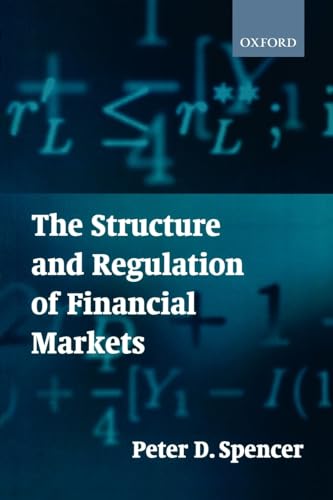Articoli correlati a The Structure and Regulation of Financial Markets

The text begins with an analysis of adverse selection in retail financial products like life assurance before looking at open capital markets where trades and prices provide information. It then progresses to the more complex areas of corporate governance and financial intermediation in which information is confidential and moral hazard and verification problems become important. These chapters study the various mechanisms that the financial markets have developed to allow investors to delegate the management of their assets to others. This analysis is used to show how regulation can reduce the risk of financial failure and how legal, accounting, and regulatory mechanisms can help shape a country's corporate and financial architecture.
These difficult theoretical concepts are conveyed through the careful use of numerical illustrations and topical case studies. Each chapter ends with a set of exercises to test and reinforce students' comprehension of the material. Worked solutions are provided for the numerical exercises.
Le informazioni nella sezione "Riassunto" possono far riferimento a edizioni diverse di questo titolo.
Le informazioni nella sezione "Su questo libro" possono far riferimento a edizioni diverse di questo titolo.
- EditoreOxford University Press, USA
- Data di pubblicazione2000
- ISBN 10 0198776101
- ISBN 13 9780198776109
- RilegaturaCopertina flessibile
- Numero di pagine284
Compra nuovo
Scopri di più su questo articolo
Spese di spedizione:
EUR 3,73
In U.S.A.
I migliori risultati di ricerca su AbeBooks
The Structure and Regulation of Financial Markets
Descrizione libro Paperback. Condizione: new. New. Fast Shipping and good customer service. Codice articolo Holz_New_0198776101
The Structure and Regulation of Financial Markets
Descrizione libro Paperback. Condizione: new. New. Codice articolo Wizard0198776101
The Structure and Regulation of Financial Markets
Descrizione libro Paperback. Condizione: new. New Copy. Customer Service Guaranteed. Codice articolo think0198776101
The Structure and Regulation of Financial Markets
Descrizione libro Condizione: new. Codice articolo FrontCover0198776101
The Structure and Regulation of Financial Markets
Print on DemandDescrizione libro PAP. Condizione: New. New Book. Shipped from UK. THIS BOOK IS PRINTED ON DEMAND. Established seller since 2000. Codice articolo L0-9780198776109
The Structure and Regulation of Financial Markets
Print on DemandDescrizione libro Condizione: New. PRINT ON DEMAND Book; New; Fast Shipping from the UK. No. book. Codice articolo ria9780198776109_lsuk
The Structure and Regulation of Financial Markets
Descrizione libro Paperback / softback. Condizione: New. This item is printed on demand. New copy - Usually dispatched within 5-9 working days. Codice articolo C9780198776109
The Structure and Regulation of Financial Markets
Descrizione libro Condizione: New. Codice articolo ABLIING23Feb2215580044990
The Structure and Regulation of Financial Markets
Descrizione libro Condizione: New. Book is in NEW condition. Codice articolo 0198776101-2-1
The Structure and Regulation of Financial Markets
Descrizione libro Condizione: New. New! This book is in the same immaculate condition as when it was published. Codice articolo 353-0198776101-new

